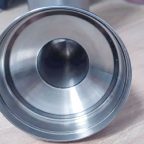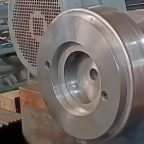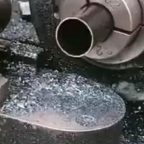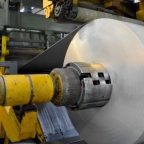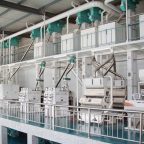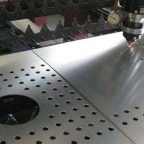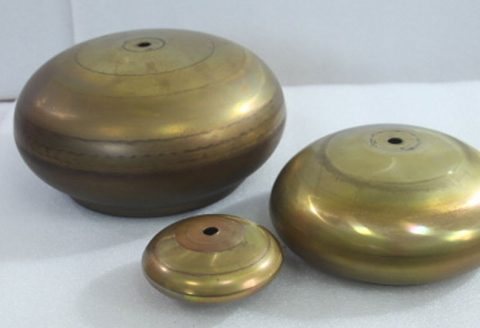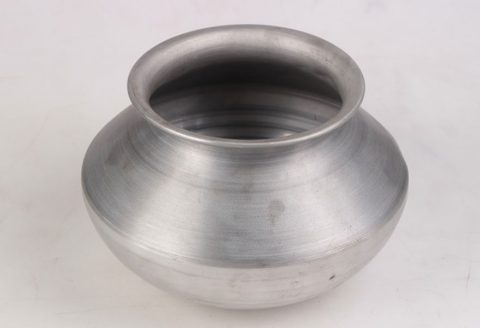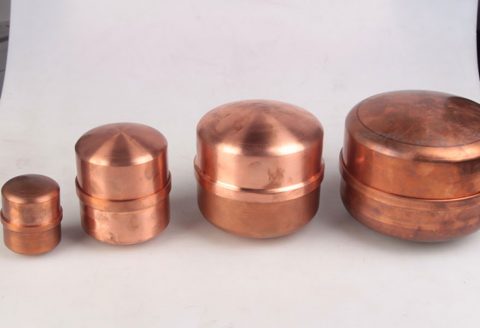
Aerospace-grade aluminum alloys, such as 2195 (Al-Cu-Li) and 2219 (Al-Cu), are pivotal in the fabrication of lightweight, high-strength components for aerospace applications, including rocket fuel tanks, aircraft envelopes, and structural panels. These alloys are prized for their exceptional mechanical properties, including high specific strength, excellent corrosion resistance, and good weldability. However, the manufacturing processes, particularly spinning, introduce complex residual stress distributions that can significantly affect the dimensional stability, mechanical performance, and long-term reliability of these components. Spinning, a metal-forming process involving the rotation of a workpiece against a tool to shape it, induces significant plastic deformation, leading to residual stresses that evolve during subsequent aging treatments. This article explores the residual stress distribution and aging stability evolution in 2195 and 2219 aluminum alloys post-spinning, delving into the mechanisms governing stress formation, relaxation, and microstructural changes during aging. By examining recent studies and experimental data, this comprehensive analysis aims to elucidate the interplay between processing parameters, residual stress, and material stability, providing insights for optimizing aerospace component manufacturing.
Background on Aerospace-Grade Aluminum Alloys
Composition and Properties of 2195 and 2219 Alloys
The 2195 aluminum alloy, a third-generation Al-Cu-Li alloy, is engineered for aerospace applications requiring low density and high strength. Its nominal composition includes approximately 4.0–4.2 wt% Cu, 0.8–1.0 wt% Li, 0.25–0.35 wt% Mg, 0.25–0.35 wt% Ag, and 0.08–0.16 wt% Zr, with aluminum as the balance. The addition of lithium reduces density by approximately 3% per 1 wt% Li and increases the elastic modulus by 6%, making 2195 ideal for weight-critical applications like cryogenic fuel tanks. The alloy’s strength is primarily derived from the T1 (Al₂CuLi) phase, which forms during aging and contributes to precipitation strengthening. The 2219 aluminum alloy, part of the 2XXX series, contains 5.8–6.8 wt% Cu, 0.2–0.4 wt% Mn, 0.02–0.10 wt% Zr, and minor amounts of Fe, Si, and other elements. Known for its excellent weldability and high fracture toughness, 2219 is widely used in aerospace structures subjected to elevated and cryogenic temperatures.
Both alloys undergo complex thermomechanical processing, including hot rolling, solution heat treatment, quenching, and aging, to achieve desired properties. However, processes like spinning introduce residual stresses that can compromise dimensional accuracy and mechanical performance if not properly managed. The interplay between residual stress and aging stability is critical, as it influences the service life and reliability of aerospace components.
Spinning as a Manufacturing Process
Spinning is a versatile metal-forming technique used to produce axisymmetric components, such as cylindrical shells and ribbed parts, by rotating a metal blank and applying localized pressure with a tool. In aerospace manufacturing, spinning is employed to fabricate thin-walled components with high precision. The process can be categorized into conventional spinning, shear spinning, and spinning extrusion forming (SEF). Shear spinning, in particular, is used for aerospace-grade aluminum alloys due to its ability to produce thin-walled structures with significant thickness reduction. The plastic deformation during spinning generates residual stresses due to non-uniform strain distributions, which are further influenced by subsequent aging treatments aimed at enhancing mechanical properties.
Residual Stress Formation During Spinning
Mechanisms of Residual Stress Generation
Residual stresses are internal stresses that remain in a material after external forces or thermal gradients are removed. In spinning, residual stresses arise from several sources:
- Plastic Deformation: The localized deformation during spinning induces non-uniform plastic strains, leading to residual stresses. The extent of deformation depends on parameters such as spinning thickness reduction, tool feed rate, and spindle speed.
- Thermal Gradients: Non-uniform heating, often from friction or external heat sources like flame torches in SEF, creates thermal gradients that contribute to residual stress formation.
- Microstructural Changes: The formation of dislocation networks, sub-grain boundaries, and dynamic precipitates during spinning alters the material’s internal stress state.
In 2195 Al-Li alloy, spinning extrusion forming (SEF) at temperatures between 200–400°C induces dynamic precipitation of phases like θ (Al₂Cu) and T1, which interact with dislocations to influence residual stress distribution. Similarly, in 2219 Al-Cu alloy, shear spinning with thickness reductions exceeding 10% produces dislocation cells and sub-grain boundaries, contributing to complex stress fields.
Measurement Techniques for Residual Stress
Several techniques are employed to measure residual stresses in spun components:
- Hole Drilling: A widely used method involving drilling a small hole and measuring relieved surface strains with a strain gauge rosette. It is effective for depths up to 1.2 mm but is sensitive to hole dimensions and surface conditions.
- X-ray Diffraction (XRD): Non-destructive and capable of measuring surface stresses by analyzing lattice strain. In-situ synchrotron radiation SAXS (Small-Angle X-ray Scattering) has been used to study stress evolution in 2XXX series alloys.
- Neutron Diffraction: Provides deeper penetration for bulk stress measurement, suitable for thick aerospace components.
- Finite Element (FE) Simulation: Models stress distribution based on material properties and processing parameters, validated by experimental data.
For example, studies on 2219 alloy rings have used hole drilling to quantify surface residual stresses, revealing a decrease in stress magnitude with increased thermal stress relief (TSR) time. In 2195 alloy, in-situ SAXS has shown that stress fields couple with temperature fields to influence precipitate evolution during aging.
Residual Stress Distribution in Spun 2195 and 2219 Alloys
The residual stress distribution in spun components is highly dependent on processing parameters. In 2195 Al-Li alloy, SEF at 200°C results in higher dislocation densities and low-angle grain boundaries (LAGBs), leading to tensile residual stresses near the surface. At higher temperatures (e.g., 400°C), dynamic recrystallization reduces stress magnitude but coarsens precipitates, affecting mechanical properties. In 2219 Al-Cu alloy, shear spinning with thickness reductions above 10% eliminates the second aging hardness peak, indicating a shift in stress distribution due to dislocation annihilation and precipitate coarsening.
Table 1 compares residual stress characteristics in spun 2195 and 2219 alloys based on recent studies:
| Alloy | Spinning Type | Temperature (°C) | Thickness Reduction (%) | Residual Stress (MPa) | Measurement Method | Source |
|---|---|---|---|---|---|---|
| 2195 | SEF | 200 | 10 | 150–200 (Tensile) | In-situ SAXS | |
| 2195 | SEF | 400 | 10 | 80–120 (Tensile) | In-situ SAXS | |
| 2219 | Shear Spinning | Ambient | 15 | 100–180 (Tensile) | Hole Drilling | |
| 2219 | Shear Spinning | Ambient | 20 | 90–150 (Tensile) | Hole Drilling |
Aging Stability and Microstructural Evolution
Aging Processes in Aluminum Alloys
Aging treatments, including natural aging (NA) and artificial aging (AA), are critical for enhancing the mechanical properties of 2195 and 2219 alloys. Natural aging occurs at room temperature, leading to the formation of Guinier-Preston (G.P.) zones and δ′/β′ precipitates. Artificial aging, typically conducted at 120–200°C, promotes the precipitation of strengthening phases like T1 (Al₂CuLi) in 2195 and θ′ (Al₂Cu) in 2219. The aging process is influenced by prior deformation, such as spinning, which introduces dislocations that act as nucleation sites for precipitates.
Effect of Spinning on Aging Behavior
Spinning alters the aging behavior by modifying the dislocation structure and precipitate distribution. In 2195 alloy, pre-deformation from spinning increases the nucleation sites for T1 phases, reducing their average size and increasing number density. This enhances strength but may reduce ductility due to localized stress concentrations. In 2219 alloy, spinning with high thickness reduction (>10%) suppresses the second hardness peak during aging, as dislocation cells hinder the transformation from θ″ to θ′ phases.
Stress Relaxation During Aging
Stress relaxation aging (SRA) is a critical process for reducing residual stresses in spun components. SRA involves holding the material at an elevated temperature (e.g., 120–190°C) under initial stress, allowing dislocations to move and precipitates to form, thereby relieving internal stresses. In 2195 alloy, SRA at 180°C with 2–4% pre-strain extends the first stress relaxation stage, promoting uniform precipitate distribution. In 2219 alloy, SRA reduces peak residual stresses by up to 50.8% at 210°C, with thermal stress relief (TSR) being more effective than vibration stress relief (VSR) or thermal-vibratory stress relief (TVSR).
Table 2 summarizes the effects of SRA on residual stress reduction in 2195 and 2219 alloys:
| Alloy | SRA Temperature (°C) | Initial Stress (MPa) | Pre-Strain (%) | Stress Reduction (%) | Method | Source |
|---|---|---|---|---|---|---|
| 2195 | 180 | 210–420 | 2–4 | 60–80 | In-situ SAXS | |
| 2219 | 210 | 100–250 | 0 | 50.8 (Transversal) | Hole Drilling | |
| 2219 | 185 | 100–250 | 0 | 42.02 (Longitudinal) | Hole Drilling |
Microstructural Changes During Aging
The microstructural evolution during aging is driven by the interplay between dislocations, precipitates, and grain boundaries. In 2195 alloy, aging at 150°C increases the number density of T1 phases, enhancing strength through shear mechanisms. At higher temperatures (e.g., 225°C), T1 phases coarsen, and T2 (Al₆CuLi₃) phases form, reducing strength due to a transition to bypass mechanisms. In 2219 alloy, aging at 120–175°C promotes θ′ precipitation, but high pre-deformation from spinning disrupts this process, leading to heterogeneous precipitate distributions.
Influence of Processing Parameters
Temperature Effects
The spinning temperature significantly affects residual stress and aging stability. In 2195 alloy, SEF at 200°C induces fine θ precipitates and high dislocation density, increasing residual stresses. At 400°C, dynamic recrystallization reduces stress but coarsens grains, lowering formability. In 2219 alloy, ambient shear spinning generates higher residual stresses than warm spinning, as thermal activation reduces dislocation entanglement.
Thickness Reduction
Higher thickness reductions in spinning increase plastic deformation, leading to greater residual stresses. In 2219 alloy, reductions above 10% eliminate the second aging hardness peak, indicating significant microstructural rearrangement. In 2195 alloy, moderate reductions (5–10%) balance stress generation and precipitate nucleation, optimizing mechanical properties.
Strain Rate and Pre-Strain
High strain rates during spinning, as in dynamic compression tests, enhance dislocation strengthening in 2195 alloy, increasing hardness by up to 63.1%. Pre-strain before aging, as studied in 2195 alloy, reduces in-plane anisotropy (IPA) by 60–90%, improving stress relaxation uniformity.
Mechanical Properties and Performance
Strength and Hardness
Spinning and aging significantly influence the mechanical properties of 2195 and 2219 alloys. In 2195 alloy, pre-deformation from spinning increases tensile strength by promoting T1 phase precipitation, but excessive deformation reduces ductility. In 2219 alloy, spinning reduces hardness at high thickness reductions due to dislocation annihilation, but SRA at 210°C restores strength through precipitate strengthening.
Table 3 compares mechanical properties post-spinning and aging:
| Alloy | Condition | Yield Strength (MPa) | Tensile Strength (MPa) | Elongation (%) | Hardness (HV) | Source |
|---|---|---|---|---|---|---|
| 2195 | SEF + SRA | 400–450 | 500–550 | 8–12 | 140–160 | |
| 2219 | Shear Spinning + SRA | 300–350 | 400–450 | 10–15 | 120–140 |
Fracture Toughness and Anisotropy
Fracture toughness is critical for aerospace applications. In 2195 alloy, T1 precipitates reduce toughness by promoting intergranular fracture, but pre-deformation mitigates anisotropy, improving formability. In 2219 alloy, aging conditions like T6 enhance fracture toughness, but spinning-induced stresses can exacerbate crack propagation if not relieved.
Residual Stress Relief Methods
Thermal Stress Relief (TSR)
TSR involves heating the component to 140–210°C to relax residual stresses through dislocation motion and precipitate coarsening. In 2219 alloy, TSR at 210°C reduces peak residual stresses by 50.8% transversally and 42.02% longitudinally, outperforming VSR and TVSR.
Vibration Stress Relief (VSR)
VSR uses mechanical vibrations to redistribute stresses. It is less effective than TSR for 2219 alloy, achieving moderate stress reduction but improving stress homogeneity in certain directions.
Thermal-Vibratory Stress Relief (TVSR)
TVSR combines thermal and vibratory methods, offering balanced stress reduction and homogenization. In 2219 alloy, TVSR achieves uniform stress distribution but is less effective at reducing peak stresses compared to TSR.
Table 4 compares stress relief methods for 2219 alloy:
| Method | Temperature (°C) | Stress Reduction (%) | Homogenization | Source |
|---|---|---|---|---|
| TSR | 210 | 50.8 (Transversal) | Moderate | |
| VSR | Ambient | 20–30 | Good | |
| TVSR | 140–210 | 30–40 | Excellent |
Dimensional Stability and Service Performance
Dimensional Stability
Dimensional stability is critical for aerospace components subjected to thermal cycling. Residual stresses from spinning can cause distortion, but SRA and TSR improve stability by reducing stress gradients. In 2195 alloy, SRA with pre-strain enhances dimensional stability by promoting uniform precipitate distribution. In 2219 alloy, TSR minimizes distortion in thin-walled components, ensuring precision in large rings.
Service Performance
The service performance of spun components depends on their resistance to fatigue, stress corrosion cracking (SCC), and creep. In 2195 alloy, T1 precipitates enhance strength but may reduce SCC resistance if coarsened. In 2219 alloy, TSR and ultrasonic impact treatment (UIT) improve SCC resistance by refining surface grains and reducing residual stresses.
Recent Advances and Future Directions
Innovations in Processing
Recent studies have explored advanced spinning techniques, such as electrically assisted electromagnetic forming (EAEMF), to enhance formability in 2219 alloy. EAEMF increases forming limits by 40–42%, improving precipitate stability. In 2195 alloy, high strain rate forming combined with heat treatment optimizes microstructure for dynamic compression applications.
Modeling and Simulation
Finite element (FE) simulations have improved the prediction of residual stress distribution and aging behavior. Unified constitutive models incorporating dislocation theory and precipitation kinetics accurately predict springback in 2219 alloy, with errors as low as 3.6%. Future models should integrate anisotropic creep and damage evolution for 2195 alloy.
Future Research Needs
Further research is needed to:
- Quantify the long-term effects of spinning-induced stresses on fatigue life.
- Develop hybrid stress relief methods combining TSR and EAEMF.
- Explore the role of minor alloying elements (e.g., Ag, Zr) in 2195 alloy aging stability.
- Enhance non-destructive stress measurement techniques for in-service monitoring.
Conclusion
The residual stress distribution and aging stability evolution in aerospace-grade aluminum alloys 2195 and 2219 post-spinning are governed by complex interactions between plastic deformation, thermal gradients, and microstructural changes. Spinning introduces tensile residual stresses that can be mitigated through SRA, TSR, VSR, or TVSR, with TSR being the most effective for peak stress reduction. Aging treatments enhance mechanical properties but must be optimized to balance strength, ductility, and dimensional stability. Recent advances in processing and modeling offer promising avenues for improving component performance, but ongoing research is essential to address challenges in anisotropy, fatigue, and long-term stability. This comprehensive understanding of residual stress and aging behavior informs the design and manufacturing of high-performance aerospace components, ensuring reliability in demanding environments.
Maximize Tooling and CNC Metal Spinning Capabilities.
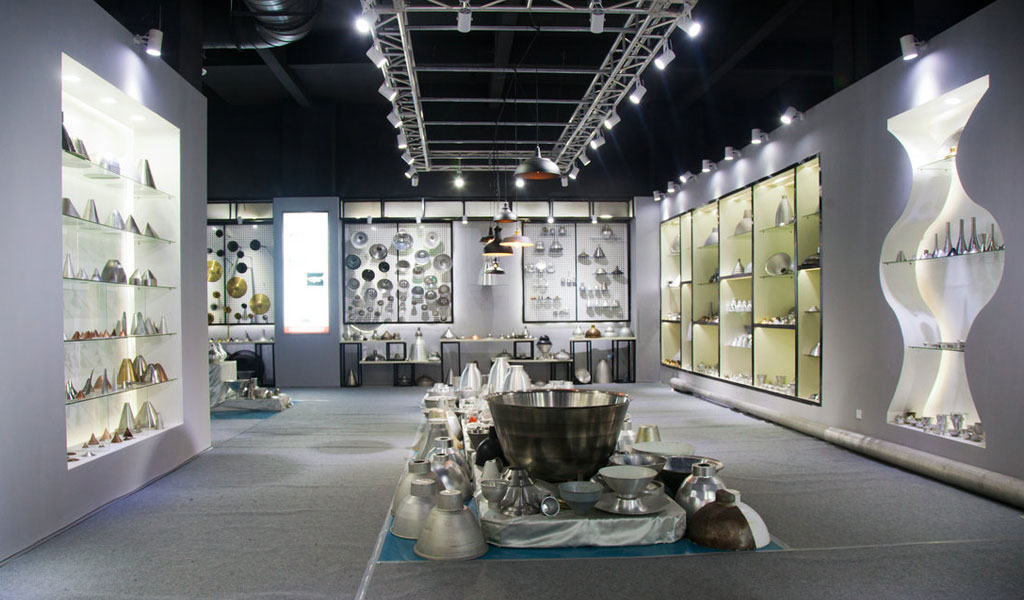
At BE-CU China Metal Spinning company, we make the most of our equipment while monitoring signs of excess wear and stress. In addition, we look into newer, modern equipment and invest in those that can support or increase our manufacturing capabilities. Our team is very mindful of our machines and tools, so we also routinely maintain them to ensure they don’t negatively impact your part’s quality and productivity.
Talk to us today about making a rapid prototype with our CNC metal spinning service. Get a direct quote by chatting with us here or request a free project review.
BE-CU China CNC Metal Spinning service include : CNC Metal Spinning,Metal Spinning Die,Laser Cutting, Tank Heads Spinning,Metal Hemispheres Spinning,Metal Cones Spinning,Metal Dish-Shaped Spinning,Metal Trumpet Spinning,Metal Venturi Spinning,Aluminum Spinning Products,Stainless Steel Spinning Products,Copper Spinning Products,Brass Spinning Products,Steel Spinning Product,Metal Spinnin LED Reflector,Metal Spinning Pressure Vessel,
